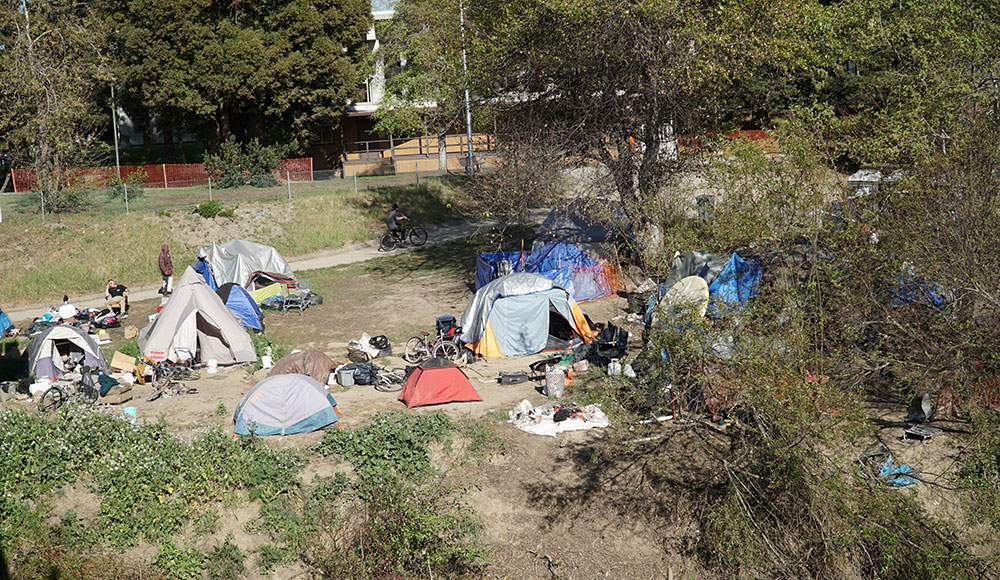The number of people experiencing homelessness across Santa Cruz County increased 2.6% in 2023 to 1,850.
Paired with inconsistent state funding and the spiraling cost of housing, this trend poses a threat to progress in managing homelessness locally.
That’s according to the Point In Time report released July 19.
“This data demonstrates the effectiveness of local investments and strategies, including the Housing for a Healthy Santa Cruz County framework, in contributing to sustainable reductions in homelessness,” Santa Cruz County Housing for Health Director Robert Ratner said. “While the overall numbers remain essentially unchanged, the full report demonstrates that our community still has challenges ahead of us in addressing this issue.”
The top causes of homelessness were job loss at 36% and eviction at 29%. Additionally, 26% of the homeless population are employed, and 45% of the population believe that employment assistance is the most effective way to prevent housing loss.
But even if the people who are homeless have jobs, they still face the challenge of paying rent. According to a recent study, Santa Cruz County has one of the least affordable rental markets in the nation, with housing costs being 20% higher compared to San Jose and San Francisco. This lack of affordable and available housing makes it extremely difficult for everyone to find safe homes, which is impacting a wide range of people within the county.
According to the PIT, between 2023 and 2024, the percentage of Latinos experiencing homelessness increased to 29%, while homelessness among seniors grew by 7%. Homelessness also affects those with physical and mental challenges: 55% of them report a disability and 46% report they suffer from a substance use disorder.
While Santa Cruz County’s numbers have increased, there has been a 36% decrease in homelessness within the city of Santa Cruz, which could be a result of investments and a pro-housing approach to addressing the affordable housing issue.
In collaboration with the county and other community partner agencies, the city of Santa Cruz has implemented various strategies to address the issue by focusing on long-term solutions that focus on the root cause of the problem.
In the past two years, 165 new shelter beds have been added and there are plans to develop 1,100 permanent affordable housing units. In addition, 45 RV-safe parking spots have been created to provide a safe place for RVs to park with on-site hygiene services.
The City of Santa Cruz recently received a $4 million grant from the State of California’s Encampment Resolution Fund that will provide 20 housing units on the Housing Matters campus, with outreach, service coordination, housing navigation, and help those living in encampments move to stable housing.
“The success of these initiatives reflects a coordinated and comprehensive approach to addressing homelessness in the City of Santa Cruz,” said Mayor Fred Keeley.















Instead of spending $4,000,000.00 to build 20 housing units at a cost of $200,000.00 per unit, we should build a three story four wing dorm style facility to house several homeless individuals instead.
The one-time cost to build a three-story dorm is more cost affective as it provides more beds to house more individuals that are experiencing homelessness.
Another consideration is that Families with children can receive more funding to house them then an individual can receive.
Priorities should be established to ensure that homeless individuals who are experiencing mental and substance abuse issues be provided a bed as soon as they are identified rather than place them in hospitals and other expensive facilities that they do not need to be in.
We can place individuals who are experiencing alcohol and substance abuse issues in separate wings designed to help them. By doing this we can monitor them and assist them to ensure that they will not harm themselves and others while onsite.
Human assistance and other Counsellors can be placed on duty to assist those who are facing mental and other medical issues onsite rather then place them in hospitals, jail cells or back on the street where they will face further abuses.
Many of our homeless, simply need a bed to sleep in, a place to clean themselves, wash their clothes and have a meal or two will be able to recover much faster. Most will be open to receive assistance so that they can obtain permanent housing.
For those who refuse housing for what ever their reason should be interviewed and then given the opportunity to stay in designated locations where they can place their tents , park their vehicle or trailers at.
All others will be required to leave the County to find alternative housing or places to stay since they do not want to follow our County Homeless Guidelines put in place by State and Federal Law.